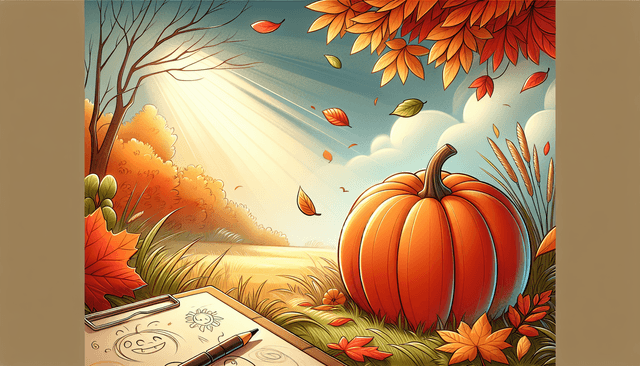Table of Contents
As the leaves change color and the air turns crisp, finding inspiration for writing can feel daunting. You might be searching for the perfect prompt that captures the essence of fall, and let’s be honest, who hasn’t faced a little writer’s block when the seasons shift?
But don’t worry! Dive into this collection of autumn writing prompts and you’ll discover creative ways to spark your imagination. Whether it’s fun stories for kids, heartfelt reflections for adults, or poetic musings about nature, there’s something here for every writer.
From whimsical Halloween tales to gratitude journaling for Thanksgiving, this guide will help you embrace the beauty of fall in your writing. Let’s get those creative juices flowing!
Key Takeaways
- Fall is a great time to overcome writer’s block with creative prompts that inspire ideas related to autumn.
- Writing prompts can range from describing your ideal autumn day to reflecting on personal experiences during the season.
- Kids can enjoy writing with simple prompts like imagining being an animal in the fall or describing a fun day outdoors.
- Adults can engage in reflective writing that draws from life’s transitions during this time of year.
- Poetry about fall can be expressed through haikus focused on nature or free verse capturing emotions and imagery.

1. Fun Fall Writing Prompts
When the leaves start to change color and the air gets a bit crisper, it’s the perfect time to get those creative juices flowing with some fun fall writing prompts. Whether you’re looking to stretch your imagination, spark your creativity, or simply enjoy the beauty of the season, autumn offers a wealth of inspiration. So grab a warm drink, cozy up, and let’s explore some engaging writing ideas for this vibrant season.
1.1 Seasonal Themes
The fall season is rich with traditions and holidays that can serve as a backdrop for your writing. From gathering around the table for Thanksgiving to celebrating Halloween’s spooky allure, seasonal themes can create a lively setting for your stories.
Consider writing about an annual fall festival in your town. What activities are there? Who do you meet? Capture the excitement of the harvest season or the comforting smells of autumn spices wafting through the air.
If you want a specific start, try this prompt: “Describe your ideal autumn day. What would you do? Who would you spend it with?” Just let your imagination run wild with the thoughts of crisp air and beautiful foliage!
1.2 Nature and Changes in Fall
Autumn brings mesmerizing changes in nature that are perfect for writing prompts. Think about the vibrant fall foliage, the sound of crunching leaves underfoot, and the feeling of the cool breeze against your skin.
You might start with a sensory description: “Write about a walk in the woods during fall. What do you see, hear, and smell?” This can lead you to explore the rich tapestry of colors and sounds unique to autumn.
For a twist, consider focusing on how these natural changes affect the emotions of your character. Do they feel joy, nostalgia, or maybe a little melancholy as they watch summer slip away?
1.3 Celebrating Fall Events
Fall is home to a variety of events that can serve as great inspiration for writing. Think about fall festivals, apple-picking trips, or even community service activities that often take place during this cozy season.
Explore local cultural traditions; you could write a piece about the history and importance of a community harvest festival. Imagine the characters who go there, what they experience, and the lessons they learn.
A fun prompt is: “Write a story that centers around a fall event. What happens when unexpected weather changes the plans?” Your stories could be a delightful mix of humor and heart!
1.4 Halloween Stories and Themes
Halloween is a treasure trove of writing inspiration. From spooky tales that send shivers down your spine to playful stories about mischievous kids in costumes, the possibilities are endless.
You might write a ghost story that begins with this prompt: “On the night of Halloween, a forgotten legend comes to life.” Think about the characters, the setting, and how their beliefs shape the story.
Or, if you want something lighter, consider writing about a haunted house with a twist: what if it was actually a friendly place where everyone learns a lesson by the end? Let your creativity take over and have fun with some frightful twists!

2. Writing Prompts for Kids
Getting kids excited about writing can be a fun challenge, especially with all the vibrant autumn themes swirling around. The key is to make writing feel like an adventure rather than a chore. Here are some engaging prompts to get young writers hooked on storytelling this fall!
2.1 Easy Prompts for Younger Writers
It’s super important to meet kids where they are with simple, relatable prompts that spark their imagination. For younger ones, think short and sweet to keep it fun and accessible.
Try starting with something like: “If you could be any animal in the fall, what would you be and why?” This not only encourages creativity but also helps kids think about their favorite animals and how they relate to the season.
Another idea is to ask them to describe a fun fall day at the park. What games do they play? What snacks do they eat? This helps them recall personal experiences and add their unique twist.
You can also organize a little contest where they draw a picture of their favorite fall activity and write a short paragraph about it. This combination of art and writing can keep their interest piqued!
2.2 Creative Story Starters for School
Classroom settings are perfect for collaborative storytelling, and these prompts can help kids develop their characters and plots in no time. Encourage youngsters to work in pairs or groups to come up with exciting narratives.
One good starter is: “A group of friends are on a quest to find the biggest pumpkin in town. What happens?” This prompt encourages adventure, teamwork, and creative problem-solving.
Consider using prompts that involve magic or fantasy, like: “On a beautiful fall day, a mysterious book appears in your classroom. What’s inside?” This brings in elements of surprise and curiosity, making it a hit with young imaginations.
Make sure to give them a chance to share their stories with the class. Celebrating each child’s creative expression can build confidence and inspire others!
3. Writing Prompts for Adults
Writing isn’t just for kids; adults can gain so much from putting pen to paper during autumn as well. Whether you want to reflect on past experiences or create intricate short stories, the fall season offers a heap of inspiration.
3.1 Reflective Writing on Autumn
Reflective writing can be an enlightening activity, especially during autumn when many people begin to consider what has transpired throughout the year. Autumn can serve as a metaphor for change, which can be incredibly comforting in uncertain times.
A great prompt is: “Write about a personal moment you experienced in autumn that changed your perspective on life.” This will encourage deeper introspection and might uncover some hidden feelings.
Another reflective idea is: “Describe how the changing leaves mirror your own life’s transitions.” This allows for powerful symbolism and a chance to explore emotional connections to the season.
Keep a journal where you jot down not just feelings but also what you see, hear, and smell during the fall. Combining sensory details with personal reflections can produce more vivid writing!
3.2 Short Stories Inspired by Fall
Short stories are a perfect way to practice storytelling skills and play with characters and plots. Use autumn themes to set the atmosphere of your narrative.
Try this prompt: “A stranger arrives in town during the harvest festival, changing everything for the locals.” This encourages writers to create suspense and explore community dynamics.
Another prompt might be: “On a chilly evening, a group of friends decides to tell scary stories around a campfire. What happens?” This not only taps into the spookiness of the season but also allows for creativity with characters and settings.
To get into the groove, you might want to pick a month, such as October, and challenge yourself to write a short story each week based on a different theme revolving around fall.
4. Poetry Prompts for Fall
Autumn’s beauty translates wonderfully into poetry, making it an ideal time to explore different poetic forms. Whether it’s a haiku focused on nature or a free verse capturing emotions, there’s so much to express.
4.1 Haiku About Autumn
Haikus are a beautiful way to capture fleeting moments of nature with a 5-7-5 syllable structure. This form encourages brevity and clarity, making it perfect for writing about the season.
Try a prompt like: “Write a haiku about the sound of leaves crunching underfoot.” This will help you focus on sensory experiences that are so vivid during fall.
You can also challenge yourself with: “Create a haiku about a foggy morning and how it feels.” This taps into the enchanting and sometimes eerie quality of autumn fog.
Writing a series of haikus can be a fun project. Perhaps you could write one for each week of fall, capturing changes as the season progresses!
4.2 Free Verse Poems Celebrating Fall
Free verse offers more flexibility than structured poems, letting your creativity flow without the constraints of rhyme or meter. This can be a fantastic outlet for your emotions and observations during the season.
Consider a prompt like: “Write a poem that personifies autumn as a character. How do they interact with nature?” This allows for imaginative exploration of the season’s qualities.
Another prompt could be: “Describe the coziness of a fall evening spent by the fire.” Use rich imagery to convey warmth, nostalgia, and comfort that come with the changing weather.
Sharing your poems with others, maybe at a local coffee shop or during an open mic night, can foster a sense of community and appreciation for the creative process.

5. Journal Prompts for the Season
Journaling is a fantastic way to capture your thoughts and feelings as the season shifts. Autumn, with its sense of change and reflection, offers a perfect backdrop for personal writing.
5.1 Daily Journaling Ideas
Daily journaling can be a powerful habit for self-discovery and creativity. Start your day by jotting down three things you observe about the changing season.
Try prompts like: “What’s your favorite way to enjoy fall?” or “Describe the taste of your favorite autumn dish.” This simple exercise keeps traditions alive and encourages mindfulness.
It can also be effective to reflect on the weather: “How does today’s weather match your mood?” This connects personal feelings to external changes, creating deeper insights.
As you write, don’t worry about being perfect. Your journal is a safe space for thoughts to flow freely. Just let ideas form without the pressure of structure.
5.2 Gratitude Journaling for Thanksgiving
Thanksgiving embodies a spirit of gratitude, making it the perfect time to focus on what you’re thankful for in your life. Set aside time once a week leading up to the holiday to list at least five things you appreciate.
Prompts such as, “Reflect on a person who made a positive impact on your life this year” or “List three things from fall that bring you joy” can inspire thoughtful writing.
Feel free to expand on each point by sharing a story or memory associated with that person or moment. This way, you’re not just listing what you’re grateful for but also connecting emotionally with your experiences.
Cultivating gratitude can help shift your focus from what you lack to what you have, and this positive mindset can uplift your spirit as the days grow shorter.
6. Group Writing Prompts
Getting together with a group to write can ignite new ideas and foster creativity. Group prompts can turn individual writing into a communal experience.
6.1 Fall Writing Challenges
Consider organizing a fall writing challenge within your group. You might set a goal, like writing a specific number of autumn-themed poems in a week.
Alternatively, you can do a writing marathon where everyone contributes a paragraph to a spooky Halloween story, passing it around until complete. This creates an unexpected and fun twist!
Set a timeframe to keep things exciting. Perhaps a weekend to produce mini-stories based on your collective experiences at fall fairs or pumpkin patches could be exhilarating!
You could even share the finished products in a casual reading session to celebrate each other’s creativity.
6.2 Collaborative Storytelling Ideas
Collaborative storytelling can be an engaging activity to enhance creativity among friends or writing groups. Start with a prompt like, “It’s a foggy autumn night, and something unusual is happening in the woods.”
Each person could take a turn adding lines or paragraphs, building upon what the previous writer introduced. This keeps narratives surprising and fresh!
Encourage mixing genres, perhaps combining spooky elements with humor for a quirky twist. Allow everyone to explore their voice while ensuring that they blend with the story.
To finish it off, you can all read the story aloud. This brings a sense of completion and can generate delightful discussions about the twists and turns that emerged.
7. Tips for Using Writing Prompts
Writing prompts can be incredibly helpful, but knowing how to best use them is key to unlocking your creativity. Here are some tips to get the most out of your writing sessions.
7.1 Choosing the Right Prompt
When selecting a writing prompt, think about what resonates with you the most. Do you prefer reflective prompts that encourage deeper thinking, or do you enjoy playful story starters?
Start by reviewing a list of prompts and asking yourself which one excites you. If one doesn’t spark your interest, let it go and try another!
Consider your current mood—sometimes writing about something uplifting can help elevate a dreary day, while other times, a more serious reflection fits perfectly.
Ultimately, the right prompt will inspire you to write, so trust your instincts.
7.2 Setting a Writing Schedule
Creating a writing schedule can help develop a consistent practice. Aim for a specific time that works for you—perhaps early mornings with a cup of coffee or cozy evenings with warm tea.
Try blocking out 15-30 minute slots a few times a week where you can focus solely on writing. This doesn’t have to be overwhelming; even short sessions add up!
Consider using a calendar or planner to keep track of your writing days. Incorporating reminders gives you a visual cue that writing time is coming up!
Give yourself grace if you miss a session; just pick up where you left off. It’s about progress, not perfection.
7.3 Staying Motivated During Fall Writing
As fall sets in, it can be easy to get distracted by various festivities or the cozy comforts of home. Try setting goals for yourself, like completing a certain number of prompts each week.
Joining a writing group or community can keep your spirits up and provide accountability. Sharing your ambitions makes it easier to stay motivated.
Also, consider rewarding yourself; treat yourself to a special snack or activity after a solid writing session. You deserve little celebrations for your hard work!
If you hit a slump, switch things up! Write in a different location, like a café or park, or try a new type of prompt that challenges you in an unexpected way.
8. Conclusion: Embracing the Season Through Writing
As autumn arrives, it brings a kaleidoscope of inspiration to our writing. Whether you’re crafting stories, reflecting in your journal, or swirling poetry, this season can connect you to your thoughts and emotions.
By using prompts thoughtfully and engaging with the world around you, you can enhance your writing practice. Embrace the changes around you and see how they influence your words on the page.
Take the time to appreciate the beauty of fall—it can lead you to unexpected ideas and enrich your creative journey. So curl up, grab your favorite writing tool, and let this vibrant season guide your creativity!
FAQs
Fun fall writing prompts for kids include describing their favorite autumn activity, writing a story about a Halloween adventure, or creating a poem about falling leaves. These prompts encourage creativity and help develop writing skills.
Adults can use fall writing prompts to reflect on personal experiences, gratitude, and seasonal changes. Writing about autumn themes encourages mindfulness and deeper self-exploration, making it a valuable practice.
To effectively use writing prompts during fall, choose prompts that resonate with you, set a regular writing schedule, and stay motivated by joining writing groups or challenges. This keeps your writing enjoyable and productive.
Ideal poetry prompts for autumn include writing haikus about seasonal changes, crafting free verse poems that celebrate the beauty of fall, or exploring emotions tied to events like Thanksgiving and Halloween.



